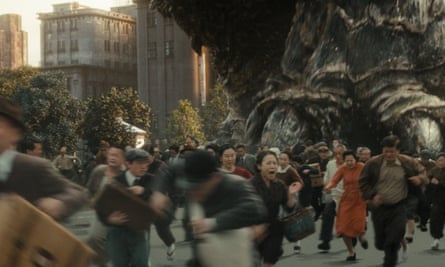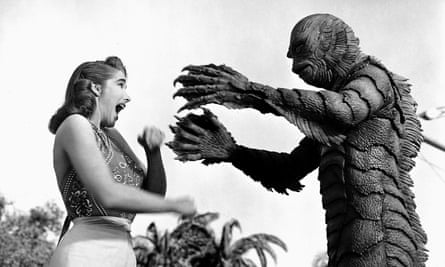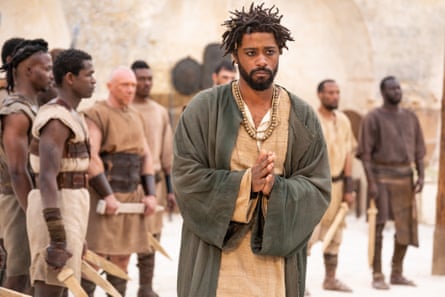You would be forgiven for not knowing this, given the disparity between its on-screen noise levels and its off-screen impact, but the second highest-grossing film of the year so far is Godzilla x Kong: The New Empire. Less a film than a canny branding marriage, it has a title you may not be able to pronounce correctly (though I’m informed that it’s not Godzilla Times Kong), though it gives an otherwise easily recognisable proposition: two heavily franchised movie monsters, Japan’s mega-lizard and Hollywood’s ultra-ape, go head to head. “New Empire” is a lofty description for the loud, garishly computer-generated warfare that ensues, but the film is otherwise honest about what it’s offering.
It just looks joylessly cynical stood besideGodzilla Minus One, last year’s winningly old-school stompathon from Japan’s Toho Studios, which cost a small fraction of what its Hollywood counterpart did and looks several times more handsome and visually coherent. (Its underdog win for best visual effects, a first for a non-English language film, was a highlight of this year’s Oscars.) With both films now available to view at home – Godzilla Minus One finally landed on Netflix earlier this month – you can take your pick.
The success of both films signifies that, even as the superhero film has run into some commercial trouble of late, there’s still life in the straight-up monster movie – even one featuring the medium’s most grizzled monsters. It’s now 91 years since King Kong first terrified and oddly moved audiences with his skyscraper-climbing antics; it’s exactly 70 since the original Godzilla (Internet Archive), whose city-vanquishing assault on Japan struck a national nerve less than 10 years after the bombings of Hiroshima and Nagasaki.

If Godzilla qualifies as a great movie monster based on his sheer indomitable absurdity, it’s the comparatively human vulnerability of Kong that makes him one – the same virtue that keeps film-makers returning to Frankenstein’s monster, decades after James Whale’s 1931 film (Frankenstein) unimprovably translated the Gothic tragedy of Mary Shelley’s novel into brash Hollywoodese. Ditto The Wolf Man, now Frankenstein’s sibling in the pantheon of Universal Pictures monsters: the 1941 werewolf origin story works up considerable pathos for its wretched anti-hero in just 70 minutes, and a procession of remakes and reboots (with another to come next year) haven’t matched it.
With such long-established lore and iconography, the werewolf is a mainstay of the monster-movie genre: back in 1981, John Landis gave the creature a new veneer of comedy and sex appeal inAn American Werewolf in London(Prime), while Joe Dante’s The Howling opted for genuine, grown-up menace over camp. It’s a fairly straight-faced outing from Dante, a monster-movie specialist who otherwise revelled in B-movie gags and shocks. In Gremlins, he lured young audiences with the most cutely monstrous critters imaginable short of Pixar’s outright cuddly Monsters Inc. (Disney+), or drumming up a gleeful farce around mutant flesh-eating fish in Piranha.

Staying in the water, some would call Steven Spielberg’s immaculate Jaws the ultimate monster movie, though to me, the genre is defined by a hint of the supernatural, or at least the ridiculous: giant-alligator-romp Lake Placid may not be a patch on Jaws as cinema, but it’s a more true-blue monster movie. The murky depths of lakes and oceans are an ever-renewable source of monster-movie threat, be it the grotesque squid-like being that calls the shots in Bong Joon-ho’s sensational The Host, a film that strikes a rare sweet spot between grandiosity and silliness, or the self-explanatory (and these days, none too scary) Creature from the Black Lagoon, preying on female bathers in early 3D. Guillermo del Toro – already established as our modern poet of the monster movie via films as grisly as Mimic and as graceful as Pan’s Labyrinth – paid homage to said Creature in his 2017 Oscar favourite The Shape of Water, recreating its gill-heavy appearance but reinventing him as a benevolent figure of desire.
Still, sometimes the most effective movie monsters are the ones that can’t be so plainly seen or identified – which often puts the more cash-strapped films at a creative advantage. British director Gareth Edwards cleverly delayed the key reveal in his resourceful, rather beautiful 2010 indie Monsters, making much of mist and stray, slithering tentacles; another British shoestring production, The Descent, effectively plays darkness against what we could see of its flesh-eating crawlers. American indie horror It Follows kept us tensely guessing throughout as to what “it” actually was, sparing its budget but not our nerves. Finally, The Thing – like David Cronenberg’s deliciously disgusting The Fly, a taut 1980s improvement on a throwaway 1950s monster movie – went all out on grotesque effects, but in service of a monster so uncannily shape-shifting that we never quite get the measure of it. A monster movie was never so banally or ideally titled.
Also new on streaming
I Am: Celine Dion
(Prime)
Céline Dion is such an untrammelled survivor – of illness, of tragedy, of changing pop trends, of snide critical mockery – that it’s hard not to feel some affection for her even if you’re still haunted by My Heart Will Go On’s chart reign of terror. This conventionally constructed documentary, focusing equally on her cast-iron career and her battle with stiff-person syndrome, will likewise move many viewers in spite of themselves, though of course it’s first and foremost aimed at her staunchest fans.

The Book of Clarence
(Sony)
Bafta-winning director Jeymes Samuel’s oddball alternative Bible story – starring LaKeith Stanfield as the weed-smoking black-sheep brother of Thomas the Apostle – bombed in cinemas, and perhaps not surprisingly so: its mixture of earnest spirituality and Life of Brian-style irreverence doesn’t have an obvious audience. But it’s just strange enough, and striking enough, to build its own small, gradual cult.
Io Capitano
(Mubi)
Matteo Garrone’s Oscar-nominated migrant epic is his best work since 2008’s Gomorrah: a rousing, ravishingly shot realist adventure that imagines the plight of a Senegalese teen (magnetically played by Seydou Sarr) attempting to reach European shores as the stuff of mythic legend.
Source: theguardian.com

















